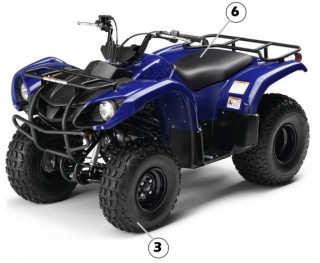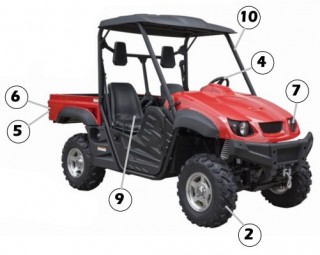Buying & Registering Your First ATV / UTV
If you're in the market for buying your first ATV / UTV, there are a few things you're going to want to consider before you take the first step into the off-road motorized recreation world. By now, you've probably searched the internet for the best models and found some helpful posts online. Keep in mind that asking "what's the best ATV / UTV" in a group of people will give you more answers than what you're looking for. In the end, it all depends on what you're looking for and what fits your needs.
ATV... UTV... What's the difference?
It wasn't long ago that we only had one choice for what to ride. An All-Terrain Vehicle, or ATV. It actually started back in the 1980's with the introduction of the three wheeler. WATVA put together a history of ATVing book that you can access here.
For Wisconsin, we have laws that actually define what an ATV and UTV are. This helps manage what goes on our trails, as our trails are built for and designed for specific vehicles. Let's take a look at the definitions of an ATV and UTV for Wisconsin:
All-Terrain Vehicle
The definition of All Terrain Vehicles is found in state laws [§340.01(2g)]. A vehicle must meet each and every legal specification in order to be eligible for registration with the Department of Natural Resources.
Here is the definition of an ATV in Wisconsin:
- Commercially designed and manufactured;
- A motor-driven device;
- Travels on three or more low pressure or non-pneumatic tires;
- Dry weight of 900 pounds or less;
- Width of 50 inches or less; and
- Equipped with a seat designed to be straddled by the operator
Utility Terrain Vehicle
State laws [§23.33 (1)(ng)] require a vehicle to meet one of two definitions before it can be registered as a UTV. A vehicle must meet each and every legal specification in order to be eligible for registration with the Department of Natural Resources.
Here is the definition of a UTV in Wisconsin:
- Commercially designed and manufactured;
- Four or more low pressure or non-pneumatic tires;
- Dry weight of 3,000 pounds or less;
- Steering Wheel;
- One or more tail lights;
- One or more brake lights;
- Two headlights;
- Width of 65 inches or less;
- Seat belts for every occupant; and
- Roll bar or device that protects occupants during a
Vehicles that would not qualify as an ATV because of their weight can be registered as a UTV if they meet all of the following specifications:
- Commercially designed and manufactured;
- Three or more low pressure or non-pneumatic tires;
- Dry weight more than 900 pounds but less than 2,000 pounds;
- Width of 50 inches or less; and
- Equipped with a seat designed to be 2 straddled by the operator
Registration Requirements
- display current Wisconsin registration decals, or
- possess a temporary operating receipt or
- possess a copy of a signed registration application from a dealer.
Displaying Your Registration:
Machines registered with the DNR are issued two decals. The decals must be displayed on both sides of the machine, in a position which is forward of the operator and visible to law enforcement. Until decals are received by mail, operators must possess the temporary operating receipt issued for the machine. Operators should carry all necessary registration cards and paperwork with them for display to a law enforcement officer upon request.
Rear Registration ID Plate Requirement
All ATVs/UTVs required to register for Public Use shall have a plate attached to the rear of the vehicle. Private and Private-Agricultural registrations do not need a plate. The plate may be constructed by the owner or commercially purchased. Plate specifications must be:
- Minimum of 4 inches high and 7 1/2 inches wide.
- The plate must be white in color and display the four-number and two-letter registration ID in black characters for the ATV/UTV issued by the department. The minimum 4" x 7 ½" area must be white and must only contain the registration ID characters. Plates may be larger than the minimum size and the area outside the minimum white area may contain other graphics or colors. The registration ID numbers are located on the registration decals and registration certificate card.
- The registration ID numbers shall be a minimum of 1 1/2 inches in height, and a minimum of a 3/16-inch stroke (width).The plate may be made from any type of material, but must be visible and in a legible condition at all times.
In addition to the plate, when received, Public Use registration decals must be affixed to each side of the vehicle in a place that is forward of the operator and clearly visible to law enforcement.


